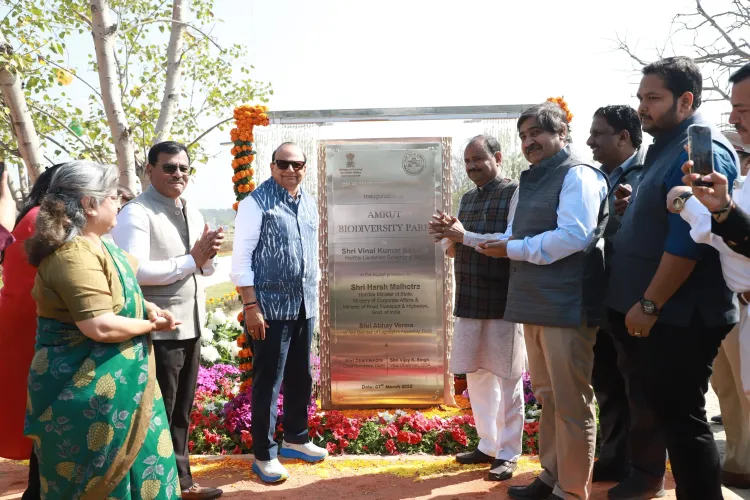Delhi's Lieutenant Governor Unveils Amrut Biodiversity Park on Yamuna Floodplains Near CWG Village

Synopsis
Key Takeaways
- Inauguration of Amrut Biodiversity Park by LG V.K. Saxena.
- Park spans over 90 hectares on Yamuna's eastern bank.
- Focus on managing stormwater and reducing flood risks.
- 14,500 trees and 3.21 lakh grasses planted for biodiversity.
- Public interfaces established for community engagement.
New Delhi, March 7 (NationPress) In a significant move to enhance biodiversity within urban settings, Delhi's Lieutenant Governor V.K. Saxena officially launched the Amrut Biodiversity Park located in the Yamuna Floodplains. He emphasized that the rejuvenation of the river is a primary focus for the government.
During the inauguration, LG Saxena stated, “The restoration and rejuvenation of Yamuna flood plains is of utmost importance. Our goal is a Green Delhi, and we are committed to achieving it through a dedicated mission.”
Key attendees included Member of Legislative Assembly Abhay Verma, Chief Secretary Dharmendra, Vice Chairman of DDA Vijay Kumar Singh, along with other government dignitaries.
Constructed as part of the Yamuna floodplain restoration initiative by the Delhi Development Authority, the Amrut Biodiversity Park covers over 90 hectares on the eastern banks of the Yamuna River.
This area, which was previously underutilized for agriculture, nurseries, and settlements, had faced significant degradation of its natural floodplain, soil quality, and indigenous plant life.
According to a DDA representative, “The land has a flat topography with an overall slope leading away from the Yamuna River, creating small catchment zones that collected water from annual floods, leading to the development of gullies within the area.”
To address the site’s flood vulnerability, the park’s design includes landscape features tailored for stormwater management, flood risk reduction, and enhancement of the local water table through natural filtration. The six water bodies within the park can store 225 million litres of water.
To reinforce the slopes, jute has been utilized, and grass has been planted to stabilize these areas, as they are susceptible to flooding during heavy rains. Additionally, unpaved pathways have been created for walking and jogging amidst the lush plantations, noted the official.
In a bid to restore biodiversity, around 14,500 trees of various species have been planted, including Neem, Kachnar, Cluster Fig, Peepal, Pilkhan, Chilbil, Senegalia catechu, Champaca, Mango, Mahua, Spanish Cherry, Kaim, White Mulberry, Kadamba, Jangal Jalebi, Kanak Champa, Amla, Karanj, Elaeocarpus ganiturs, Ashoka Tree, Jamun, Trumpet Tree, Imli, Tamarix, Teak, Arjuna, Baheda, Siris, Kala Siris, Star Fruit, and Madagascar Almond, as stated by the National Botanical Research Institute.
Moreover, approximately 18,000 shrubs and around 3.21 lakh riverine grasses have been introduced, establishing a strong riverine grass ecosystem.
To encourage public interaction with nature, two public areas have been created along NH-24, near the CWG Village. These zones provide facilities that connect visitors to the natural environment, even during periods of flood-induced inundation.
By integrating nature into the urban core and along main highways, the Amrut Biodiversity Park aims to enhance air quality, cool urban temperatures, and promote a healthier environment, addressing the challenges of rapid urban growth, as per the statement.
This park will not only provide relief to the city’s inhabitants but will also restore the local ecosystem and encourage water conservation.









